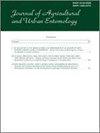三种纳米颗粒对不同粒级稻瘟病的杀虫效果
Q2 Agricultural and Biological Sciences
The Journal of Agricultural and Urban Entomology
Pub Date : 2020-07-08
DOI:10.3954/1523-5475-36.1.90
引用次数: 6
摘要
摘要:土甲(Trogoderma granarium Everts,鞘翅目:皮蝇科)是世界范围内重要的储粮小麦害虫。近年来,纳米颗粒已成为最具发展前景的害虫治理新工具之一。本实验室研究评估了三种市售纳米颗粒[氧化硅(SNPs)、氧化铝(ANPs)和氧化锌(ZNPs)]在50、100和200 mg kg-1浓度下对小麦赤霉病的杀虫效果。分别在暴露1、3、5、7 d后评价snp、ANPs和ZNPs对小麦、大麦、水稻、白玉米和黄玉米的影响。纳米颗粒类型、施用量、籽粒类型和昆虫发育阶段对小仓鼠校正死亡率有显著影响。SNPs和ANPs比ZNPs更有效,ZNPs浓度最高时二龄虫死亡率为100%。200 mg kg-1 SNPs、ANPs和ZNPs处理的小麦二龄虫死亡率显著高于其他处理。在200 mg kg-1浓度下,纳米颗粒对大麦和小麦二龄虫的杀虫效果显著高于对水稻和玉米的杀虫效果。首先,以200 mg kg-1的速率暴露于所有纳米颗粒类型的二、三龄星比四、五龄星和成人更容易感染。以200 mg kg-1的剂量接触所有纳米颗粒处理过的小麦的雌性成虫完全停止了繁殖。结果表明,市售SNPs和ANPs可以作为小麦的生态管理策略;然而,需要在商业储存条件下进行进一步的研究。本文章由计算机程序翻译,如有差异,请以英文原文为准。
Insecticidal Efficacy of Three Nanoparticles for the Control of Khapra Beetle (Trogoderma granarium) on Different Grains
ABSTRACT The khapra beetle, Trogoderma granarium Everts (Coleoptera: Dermestidae), is an important pest of stored wheat worldwide. Nanoparticles have become one of the most promising new tools for insect pest management in recent years. This laboratory study was conducted to evaluate the insecticidal efficacy of three commercially available nanoparticles [silicon oxide (SNPs), aluminium oxide (ANPs) and zinc oxide (ZNPs)] against T. granarium at 50, 100 and 200 mg kg–1. The efficacy of SNPs, ANPs and ZNPs on wheat, barley, rice, white maize and yellow maize was assessed after 1, 3, 5 and 7 d of exposure. Corrected mortality of T. granarium was significantly affected by nanoparticle types, application rates, grain types, and the insect developmental stages. SNPs and ANPs were more effective than ZNPs, where 100% mortality of second instars was obtained at the highest concentration. Mortality of second instars on wheat treated with SNPs, ANPs or ZNPs at the rate of 200 mg kg–1 was significantly higher than other concentrations. Insecticidal efficacy of all nanoparticles at the rate of 200 mg kg–1 against second instars was significantly higher on barley and wheat than those on rice and maize. First, second and third instars exposed to all nanoparticle types at the rate of 200 mg kg–1 were more susceptible than fourth and fifth instars and adults. Female adults exposed to wheat treated with all nanoparticles at the rate of 200 mg kg–1 stopped reproduction completely. The results demonstrate that commercially available SNPs and ANPs can be used as eco-friendly management strategy of T. granarium; however, further studies under commercial storage conditions are required.
求助全文
通过发布文献求助,成功后即可免费获取论文全文。
去求助
来源期刊

The Journal of Agricultural and Urban Entomology
Agricultural and Biological Sciences-Insect Science
CiteScore
1.40
自引率
0.00%
发文量
2
期刊介绍:
The Journal of Agricultural and Urban Entomology (JAUE) (Journal of Agricultural Entomology, Jan 1984 - Oct 1998 volumes 1-15) is published under the auspices of the South Carolina Entomological Society (SCES). The Journal publishes contributions of original research concerning insects and other arthropods of agricultural and urban importance to include those affecting humans, livestock, poultry, and wildlife. JAUE is particularly dedicated to the publication of articles and notes pertaining to applied entomology, although it will accept suitable contributions of a fundamental nature related to agricultural and urban entomology.
 求助内容:
求助内容: 应助结果提醒方式:
应助结果提醒方式:


